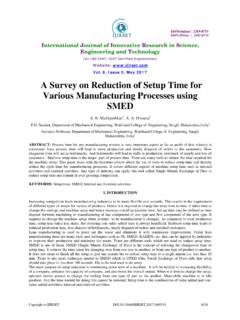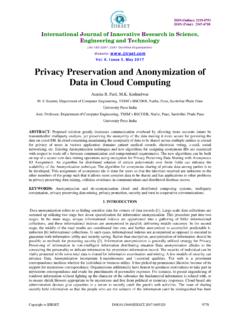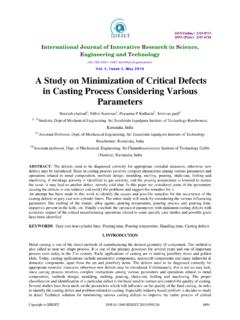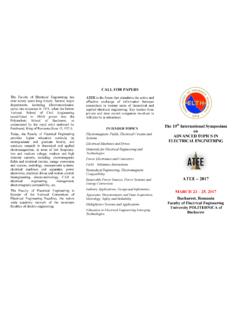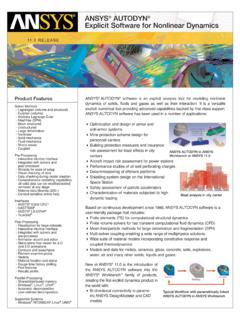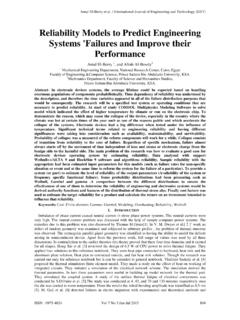Transcription of Vol. 6, Issue 3, March 2017 Analysis of Nano Tubes with ...
1 ISSN(Online) : 2319-8753 ISSN (Print) : 2347-6710 International Journal of Innovative Research in Science, Engineering and Technology (An ISO 3297: 2007 Certified Organization) Website: Vol. 6, Issue 3, March 2017 Copyright to IJIRSET 4507 Analysis of Nano Tubes with Composite Materials , 1 Assistant Professor, Dept. of Mechanical Engineering, Jay Shriram Group of Institutions, Tiruppur, Tamilnadu, India 2 Final year Student, Dept. of Mechanical Engineering, Jay Shriram Group of Institutions, Tiruppur, Tamilnadu, India ABSTRACT: ThereThree-dimensional finite element (FE) model for armchair, zigzag and choral single-walled carbon nanotubes (SWCNTs) is proposed.
2 The model development is based on the assumption that carbon nanotubes, when subjected to loading, behave like space-frame structures. The bonds between carbons atoms are considered as connecting load-carrying members, while the carbon atoms as joints of the members. To create the FE models, nodes are placed at the locations of carbon atoms and the bonds between them are modeled using three-dimensional elastic beam elements. The elastic module of beam elements are determined by using a linkage between molecular and continuum mechanics. The investigation includes armchair and zigzag SWCNTs. It is found that the choice of Vander wall forces, the interaction significantly affects the calculation of Young s modulus. The obtained values of Young s modulus agree very well with the corresponding theoretical results and many experimental measurements. Dependence of elastic module to diameter and length of the nanotubes is also obtained.
3 The presented results demonstrate that the proposed FE model may provide a valuable tool for studying the mechanical behavior of carbon nanotubes and their integration in nanocomposites. So for we dealt with single walled carbon nanotubes, in our case, we are going to consider into doubled walled carbon nanotubes generally speaking multi-walled carbon nanotubes. The therefore properties so obtained is completely different that of single walled. The DWCNT Then modeled in ANSYS-metaphysics then in is analyzed for the mechanical properties using the same. The elements were considered as beam4, it is an uniaxial element with tension, compression, torsion, and bending capabilities. The element has six degrees of freedom at each node: translations in the nodal x, y, and z directions and rotations about the nodal x, y, and z axes. Stress stiffening and large deflection capabilities are included. The interaction between the two layers of the MWCNT, the Vander walls integration, is considered in the calculation of mechanical parameter.
4 The integration are also made of beam element, which researchers have not so far attempted to work on. KEYWORDS: Analysys of internal strength of nanotube I. INTRODUCTION Composites and Nano-composites:Composite materials are engineered material made from two or more constituent materials with significantly different physical or chemical properties which remain separate and distinction a macroscopic level within the finished as a nano composite is as a multiphase solid material where one of the phases has one, two or three dimensions or structures having nano-scale repeat distances between the different phases that make up the material. The definition can include porous media, colloids, gels and copolymers, but is more usually taken to mean the solid combination of a bulk matrix and nano-dimensional phase differing in properties due to dissimilarities in structure and chemistryNano composites differ from conventional composite material due to the exceptionally high surface to volume ration of the reinforced phase or its exceptionally high aspect ratio.
5 Say large amount of reinforcement surface means that a relatively small amount of nanoscale inforcement can have an observable effect on the nanoscale properties of the composites. For example adding carbon nanotube improves the electrical and thermal conductivity, it also increases optical and dielectric, heat resistance, mechanical ISSN(Online) : 2319-8753 ISSN (Print) : 2347-6710 International Journal of Innovative Research in Science, Engineering and Technology (An ISO 3297: 2007 Certified Organization) Website: Vol. 6, Issue 3, March 2017 Copyright to IJIRSET 4508 properties like stiffness, strength, resistance to wear and damage.
6 1`2 CARBON NANO TUBE Carbon nanotubes are hollow cylinders with diameters ranging from 1nm to 50 nm and length over 10 consist of only carbon atoms and can be bought of as a graphite sheet that has been rolled into a seamless are two kinds of nanotube;one is a single-wall nanotube that is made up of a single layer of graphite ( graphite sheet ) and the other is a multi wall nanotube that consists of multiple shells. Nanotube have a lightweight and high elastic modulus, and thus they are predicted to the strongest fibers that can made. When the nanotubes are bent, it does not fracture but buckles like a rubber hose. II. ATOMIC STRUCTURE OF CARBON NANOTUBE(CNT) There are two types of CNTs: single walled carbon nanotubes (SWCNT) and multi wall carbon nanotubes (MWCNTs) are composed of co-axially situated SWCNTs of different radii. There are several ways to view a SWCNT. The most widely used is by reference to rolling up grapheme sheet to form a hollow cylinder with end caps.
7 The cylinder is composed of hexagonal carbon rings [12], while the end caps of pentagonal rings. The hexagonal pattern is repeated periodically leading to binding of each carbon atom to three neighboring atoms with covalent bonds. This covalent bond is a very strong chemical bond and plays significant role to the impressive mechanical properties of graphite and as a consequence, of all carbon-related nano-structure. Fig 1: Schematic of hexagonal lattice grapheme Finite Element Modelling: CNTs carbon atoms are bonded together with covalent bonds forming an hexagonal lattice. These have a characteristic bond length a C-C and bond angle in the 3D space. The displacement of individual atoms under an external force is contrained by the bonds. Therefore, the total deformation of the nanotubes is the result of the interactions between the bonds. By considering element, CNTs may be simulated as space-frame structures.
8 Fig 2: Fem model of nanotubes ISSN(Online) : 2319-8753 ISSN (Print) : 2347-6710 International Journal of Innovative Research in Science, Engineering and Technology (An ISO 3297: 2007 Certified Organization) Website: Vol. 6, Issue 3, March 2017 Copyright to IJIRSET 4509 The 3D model is developed using the ANSYS commercial FE the modeling of the bonds, the 3D elastic BEAM4 ANSYS element is used. The specific element is a uni-axial element with tension, compression, torsion, and bending capabilities. Fig 3: Front view and top view of the finite element mesh Multi walled carbon nanotubes Carbon nanotubes can be considered as a large molecule consisting of carbon atoms, forming a hexagonal mesh.
9 It may also be regarded as a one atom thick sheet of graphite, rolled into a tube with high aspect ratio. Such a tube can be considered as a fundamental structural unit,known as single-walled carbon nanotubes. Distance between the layers or wall equal to 034 nm. Fig 4: Perspective view of DWCNT ELEMENT MODELING OF CARBON NANOTUBES USING ANSYS-MULTIPHYSICS ANSYS-FE code generated armchair mesh: The following shows the code generated model for zigzag (10, 0) for 11 nm length, this is the SWCNTs mode one layer of carbon and the beam element mesh Output: ISSN(Online) : 2319-8753 ISSN (Print) : 2347-6710 International Journal of Innovative Research in Science, Engineering and Technology (An ISO 3297: 2007 Certified Organization) Website: Vol.
10 6, Issue 3, March 2017 Copyright to IJIRSET 4510 Fig 5: ANSYS-FE code generated for armchair mesh ANSYS-FE CODE GENERATED FOR ZIGZAG MESH: The following shows the code generated model for Zigzag (10, 0) for 11nm length, this is also of same type as armchair, the difference being the carbon atoms (node point) arrangement. Output: Fig 6: ANSYS-FE CODE GENERATED FOR ZIGZAG MESH ANSYS-FE code generated for DWCNT armchair mesh: As said earlier, MWNTs are concentrically nested SWNTs, with distance between the layers or wall equal to nm. In DWCNT as the name suggest only two layers were considered. It is to be noted that only two layers and no Vander wall interaction is not considered here. Fig 7: Armchair ansys model, without vander wall ISSN(Online) : 2319-8753 ISSN (Print) : 2347-6710 International Journal of Innovative Research in Science, Engineering and Technology (An ISO 3297: 2007 Certified Organization) Website: Vol.
